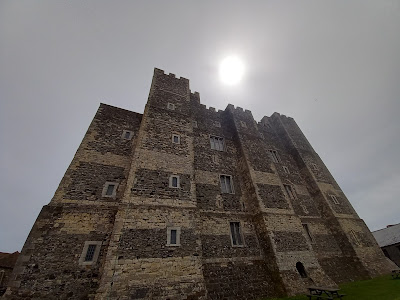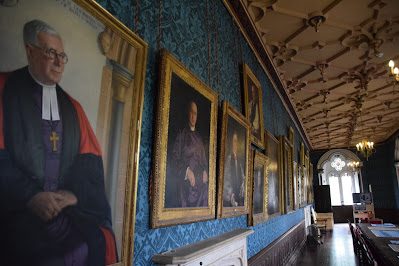So far on our peregrinations from Portslade we’ve headed
west to explore sites in West Sussex. Today, we headed east with two
destinations in mind: Michelham Priory & Gardens, and the Anne of Cleves House museum in Lewes.
There wasn’t any hurry to leave as the priory doesn’t open
until 10:30. We set out towards Upper Dicker (fnarr!) and Sattie gave us an arrival
time of 10:23, so we (and a few other people) were milling around outside at
opening time. 10:30 passed…then 10:31. In fact, it wasn’t until 10:35 (I
know!) that the door was opened and we were able to effect an ingress.
Clearly they live on country time here.
 |
| Thou shall not pass! |
Inside the house there were information leaflets and
exhibitions, but even more information was provided by the two guides who
helped us and explained everything about the priory, its inception in the 13th
century, its uses and misuses – one prior had slackened the rules to allow bad
behaviour, such as chatting during meals and fornication with local villagers.
It wasn’t made clear which of these was considered the worse sin. The house was
extended from its original size during the Tudor period, then extensively
remodelled and updated in the late 19th century. Some of the renos
were a bit unsympathetic – the original huge arched window was cut in half by
having a new floor level inserted into the building, and the arch is now
completely indoors.
 |
| Original window arch |
The guide demonstrated the weight-driven spit in the
kitchen, which worked through a complicated set of gears. Early kitchen gadgets!
Older folk probably thought it was the work of the devil.
We were also shown the inside of a cast iron strong box,
used for storing important documents and valuables. It even had a dummy keyhole
on the front to fool any would-be
peterman, with the actual keyhole cunningly
hidden. The intricate internal mechanism is shown:
After the
dissolution of the monasteries the priory passed
into private hands. In the 20
th century it was used for various
purposes, including as a home for
evacuees from the East End during
the Blitz,
and then as billets for Canadian officers, then
ATS and
Home Guard. Finally it
was bought by one
Mrs. Hotblack, who then gifted it to the
Sussex Archaeological Society to be preserved for posterity.
We were promised a working water mill, but it's not working
at the moment, as the river has silted up. It hasn’t been dredged for three
years by the Environment Agency, because teh covids*, apparently.
We lunched in the shade of a tree, again on pre-packed
sammies, then explored the rest of the gardens and grounds. These include a
Physick Garden, a great barn, and a working forge.
We drove on from there to the Anne of Cleves House Museum in
Lewes. We put the directions into Sattie, and she took us there. Unfortunately,
it's on an ordinary street in Lewes, and there’s no car park! So we then searched for nearby
parking, ended up in Lewes CBD, and had to walk 15 minutes to the house. There, we heard
about the history of the house, and how it came into Anne Of Cleves’
possession. It doesn’t appear that she actually set foot inside the place, it
was simply part of her divorce settlement from Henry VIII. As, indeed, was
Michelham Priory, although no mention was made of that during our tour there.
 |
| The house, from the garden |
We toured the rooms including the grand bedroom, which
contained a bed that Anne of Cleves never slept in.
OK, that’s enough historicalness for one day. A quick trip
to Waitrose, conveniently located next to the carpark, and we headed back home.
* Accepted spelling of this disease
















































